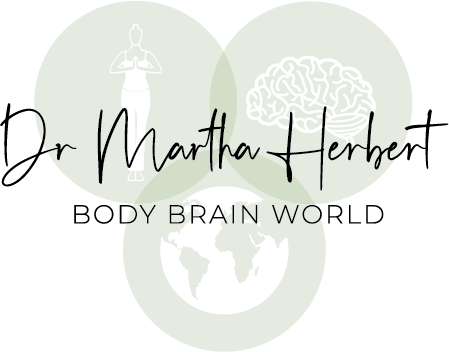I am a pediatric neurologist and a brain development researcher. For nearly two decades my main clinical, research and advocacy focus was on autism. I produced the general audience-oriented book The Autism Revolution: Whole Body Strategies for Making Life All It Can Be (Harvard Health Publications/Random House, 2012) and continue to pursue autism brain and infancy research at the interface of metabolism and electrophysiology.
My approach to autism has been rooted in my own research findings, in my clinical work, and in several decades of study prominently featuring systems theory and other wide-ranging interdisciplinary approaches.
But after much serious reflection, I have come to the conclusion that in order to achieve solutions for autism we need to embed it more clearly in the larger set of challenges of which it is a part. I believe that this is the only way we will even be able to ask the right and most productive scientific questions about core issues in autism such as what changes in the brain to produce the behaviors we label as “autistic” and what are ways that might help reverse these changes?
What are the larger set of challenges in which autism is situated?
- First, the large number of children who are chronically or frequently sick.
- Second, the large number of people who have chronic illnesses.
- Third, the growing challenges to the health of people’s brains.
- Fourth, the global crisis comprised of the myriad challenges to the health of people, including serious compromises to our food supply including food that is nutrient-poor, chemical-laden, processed and manipulated; as well as exposures to a range of toxicants, electromagnetic field and radiation exposures and stressors of other kinds, all of which may synergize in various ways to keep our cellular systems from functioning at their best.
- Fifth, the state of our planet, whose biogeochemical integrity is being challenged by the same sets of things that are challenging human health.
A critical intellectual turning point for me was co-authoring the long paper “Autism and EMF? Plausibility of a Pathophysiological Link,” now peer-reviewed, indexed on PubMed and published as Part I and Part II in the journal Pathophysiology (2013). EMFs (electromagnetic fields) target the same physiological vulnerabilities as do other toxicants. These are also major weak points for many people with autism — and many more with other chronic conditions. I have come to see autism (and many other conditions) as a problem of allostatic load or total load, which means, in simple terms, “the total build-up of too much bad stuff and not enough good stuff.” This problem in my opinion drives the chronic disease epidemic. Within this global framework, we see the difficulties posed by autism cannot be solved just within the limits of “autism.”
In the Autism and EMF? paper as well as some earlier papers, I explained the model of how the electrophysiology of how autism is something that develops and is generated by the brain micromoment by micromoment — that is, it is a PROCESS, not a hardwired fixed thing. It is also something that can potentially be unwound, at least to the point of getting rid of surplus obstructions to function.
I also believe that we are in a time of hope because many people are developing regenerative approaches to restore health and integrity to their own damaged bodies and communities, and to the soil, water and ecosystems of our planet. In the DOCUMENTING HOPE project, whose prospective FLIGHTTM intervention study has now launched (please check out our trailer! and donate to our project!) we are documenting a collaborative approach to recovery from childhood chronic illnesses and generation of “Genuine Health Transformation” through film and rigorous testing.
How do we build forward-looking solutions to specific problems that take these considerations into account? To this end I have started a foundation, Higher Synthesis Foundation, to identify and help people implement successful strategies in systems-oriented healing or regenerative activities.
